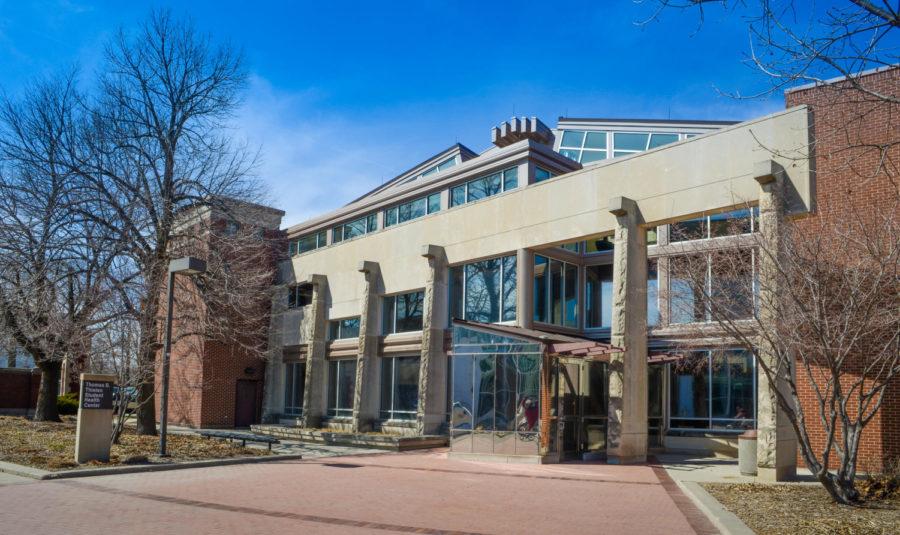Thielen receives harsh review
Thielen Student Health Center.
July 23, 2015
A comprehensive review of Thielen Student Health Center has identified a number of deficiencies at the facility, some potentially “catastrophic.”
The 59-page Keeling and Associates review, commissioned by the Office of the Senior Vice President of Student Affairs and President Steven Leath in 2014, cited problems and offered solutions in 15 areas of concern.
Quality of care, access and prevention services at the health center were identified as unacceptable, but the review pinpointed a lack of leadership as the most pressing concern.
According to the report, “A common theme expressed to K&A during our campus visit was that [the health center] suffers from a serious, chronic, and corrosive lack of leadership.”
The review also claimed there had been “a prolonged lack of skilled and effective leadership, capable operational and fiscal oversight, and accountable clinical management have seriously impaired the health center’s organizational and operational effectiveness, endangered its accreditation, undermined the quality of care and service it provides to students, created significant risks for the university.”
Leadership at the health center has been in flux since former Director Michelle Hendricks retired in September 2014.
Associate Vice President of Student Affairs Martino Harmon took over for Hendricks as interim director, but Harmon does not have a medical background. The review recommended the university hire an interim director with a background in the field and allow Harmon to return to his normal duties full time.
Mary Hensley, a retired administrator at the University of Minnesota, replaced Harmon on Monday as interim director. Harmon said a search committee plans to have a new director in place by Jan. 1 of next year.
University officials said steps have been taken to remedy the deficiencies since they received the final report March 11.
Problems and solutions
According to the review, the organizational structure of the health center was not “normative.” It called the structure “overly and unnecessarily complicated” and claimed individual units of the health center were not reporting to the logical and appropriate mangers.
Harmon said officials have taken Keeling’s advice and plan to add new management and are in the process of streamlining the organizational chart.
“We’re hiring an assistant director for administrative services,” Harmon said. All of the administrative functions will be under that position.”
Those functions include human resources, financial management, IT functions, health information management and marketing.
The report also claimed that front desk staff were making critical intake decisions without adequate support, unlicensed personnel was sometimes providing medical advice and registration processes created risks of compromise of confidential personal health information.
Harmon said the health center has added barriers at kiosks to prevent people from seeing other’s personal information and they are in the process of hiring three or four CMAs to work at the front desks.
“Even if it’s once, it’s unacceptable,” Harmon said of unsecured medical information. “That’s where I feel like stronger clinical management will help with that.”
Enrollment at Iowa State has increased by almost 38 percent since the 2007 academic year, but according to Keeling and Associates, the health center has lost providers and not replaced them.
Keeling and Associates reports that the clinic is staffed by six medical doctors, one doctor of osteopathic medicine, four certified registered nurse practitioners, three licensed practical nurses, six full-time staff nurses, 10 medical assistants and one nursing assistant. Because many employees are part time, all of those positions only add up to 9.42 full-time equivalents.
Still, if working at normative efficiency rates, those 9.42 FTEs could theoretically provide about 33,000 visits each year. Unfortunately, according to the review, if students at a school the size of Iowa State were to use the health center at normative rates, capacity for 60,000-70,000 visits would be needed.
Harmon said boosting efficiency is the goal in the short term, but increasing revenue and expanding is the goal for the future. For now, there is simply no room in the clinic to add more doctors.
“Some people think, ‘just hire more doctors,’ but you need doctors, you need nurses to work with the doctors, you need the lab and X-ray to be open… So it’s much more complicated than that,” Harmon said.
Harmon said improving efficiency on the business side of the health center is key to improving in the future.
“That’s going to be a huge focus area,” he said. “Students won’t see that directly, but what our objective is is to strengthen that area so we can develop new revenue streams. When we develop new revenue streams, then we can look at hiring more and expanding the building space.”
Mixed student opinion
The review paints a dark picture of student experience at the clinic. It claims students often can’t see a doctor in a timely fashion and are sometimes misdiagnosed.
“This year they told me I had allergies and I was continuing to be sick. I went home and I had pneumonia,” said Becky Wrolson, a junior in business.
Hannah VanGundy, a senior in design, said she knows a lot of people who won’t go to the health center because they’ll be told they’re not sick.
Student Government President Dan Breitbarth said he’s used the clinic on two occasions.
“I’ve used it twice,” Breitbarth said. “Once I had the stomach flu my freshman year and they were extremely quick and diligent about their process. Last year I used it, I had an athletic injury, I went in 30 minutes before they opened the doors and I still didn’t get to see a doctor.”
Harmon said he understands students’ frustrations, and officials are working hard to make the health center better and more efficient.
“I think that many students have a good experience at the Student Health Center,” Harmon said. “I think the primary student frustrations mostly were with getting in. I think that we are addressing that and will be addressing that more and more over time. I’m excited about the direction we’re headed in.”

















